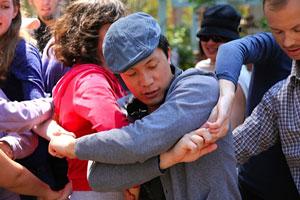Our Residents
The residents are the heart of this program, and each year we work (and play) to foster a new program community that cares for each other, educates each other and supports each other while serving the larger mission of meeting the needs and improving the circumstances of the underserved.
We see our residency not only as a communal forum for learning and growth but also as a springboard for social justice. In keeping with this aim, residents serve a patient population that consists almost entirely of Medicaid/Medicare patients and the uninsured. Outside of direct patient care, our residents pursue scholarly projects that advance the cause of social justice within the county. Recent projects include an initiative to introduce Suboxone to the county jail system (an individual project that helped create a more substantial program mentioned later), the creation of a module to educate providers county-wide about contingency management strategies, and a quality improvement project examining racial disparities in long acting injectable prescriptions. In order to do this work, our program places a high priority on the well-being of our residents and strives to ensure they are heard and respected. Residents are represented by our physician labor union, the UAPD. Finally, program leadership maintains an “open-door” policy for residents to voice their concerns. Our culture is warm and collegial.
The residents who enter our program are committed to public psychiatry and to making a positive impact on the lives of their patients, the institutions they ultimately choose to work in, and on the field of psychiatry. Their interests are diverse, encompassing service, science, humanities, and the arts. Some have pursued advanced degrees such as MPHs, MFAs, MS/MAs, and PhDs. Others have been recipients of research fellowships and awards from NGOs and cabinet-level agencies. Their enthusiasm for learning and service manifests in our curriculum, as well: senior residents mentor and teach junior residents throughout the year.
Our residents have historically had a strong presence in regional and state-level organized psychiatry. In addition, many of our residents have been awarded APA fellowships. From the 2019-2020 academic to present, six of our residents have been awarded the APA/SAMHSA Minority Fellowship, which funds community projects that address health inequities in underserved populations. In 2020-2021, one resident was awarded the single, inaugural APA Edwin Valdiserri Correctional Public Psychiatry Fellowship. In our current 2023-2024 year, we have one resident awarded an APA/SAMHSA Minority Fellowship and two Medical Education Research Fellowship for the Treatment of Addiction (MERF) scholars. A project co-led by residents and faculty has also received a California Residency Program Collaborative (CRPC) grant for training residents to perform buprenorphine starts in the county jail system.
Our program aims to graduate residents who will work in public psychiatry settings and with underserved communities. Many of our residents have gone on to fellowships in Child and Adolescent Psychiatry, Forensics, and Addiction among others. Unique to our program is the ability to fast-track into the UCSF Public Psychiatry fellowship as a fourth year resident. Our bond with this program is strong and longstanding, and this year we have sent our 8th resident in a row! In a testament to our residency community’s commitment to service and education, many of our alumni continue to be involved in the program as mentors and supervisors long after graduating.
Residents almost always report they are able to match to their top-choice fellowship. Of the class of 2022, two of our residents fast-tracked into the Child and Adolescent Psychiatry Fellowship at Stanford, one matched into the UCSF Addiction Psychiatry Fellowship, and one was hired by the Whiting Forensic Service/Yale University in Connecticut. The class of 2023 included 6 graduates, two of whom fast-tracked into Child and Adolescent Psychiatry Fellowships at Stanford (in both the regular track and the Community track), one who matched as a fourth year to the Child and Adolescent Psychiatry Fellowship at the University of Colorado, one who matched to an Addiction Fellowship at Stanford, and two who have pursued county work with San Mateo and San Francisco Counties, including as an adjunct faculty member at the UCSF Public Psychiatry Fellowship.
Current Residents

